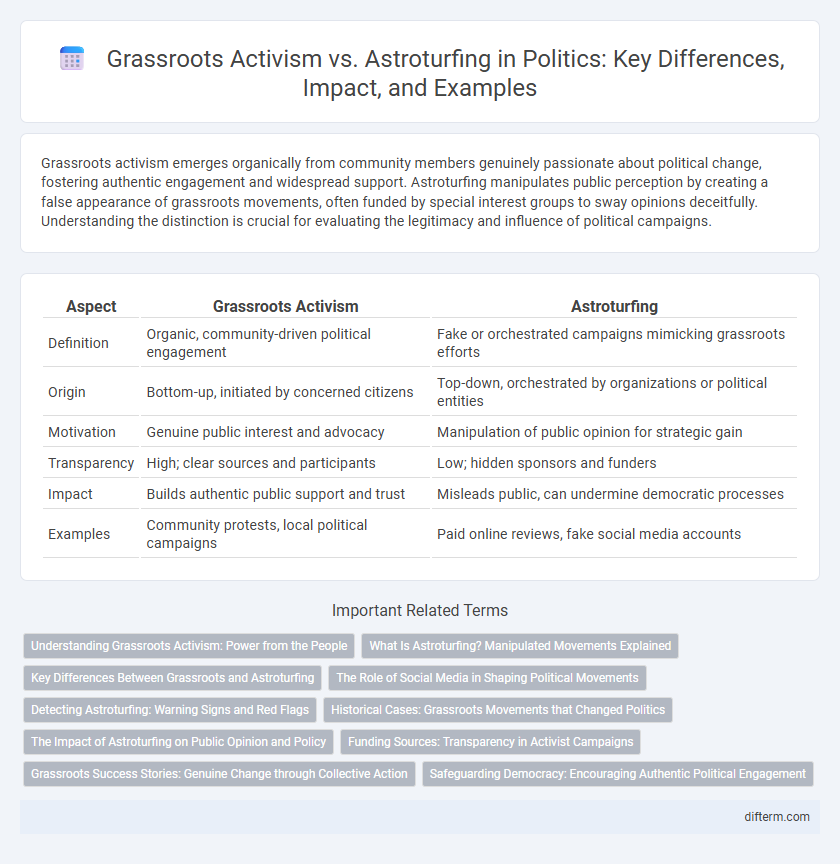Grassroots activism emerges organically from community members genuinely passionate about political change, fostering authentic engagement and widespread support. Astroturfing manipulates public perception by creating a false appearance of grassroots movements, often funded by special interest groups to sway opinions deceitfully. Understanding the distinction is crucial for evaluating the legitimacy and influence of political campaigns.
Table of Comparison
| Aspect | Grassroots Activism | Astroturfing |
|---|---|---|
| Definition | Organic, community-driven political engagement | Fake or orchestrated campaigns mimicking grassroots efforts |
| Origin | Bottom-up, initiated by concerned citizens | Top-down, orchestrated by organizations or political entities |
| Motivation | Genuine public interest and advocacy | Manipulation of public opinion for strategic gain |
| Transparency | High; clear sources and participants | Low; hidden sponsors and funders |
| Impact | Builds authentic public support and trust | Misleads public, can undermine democratic processes |
| Examples | Community protests, local political campaigns | Paid online reviews, fake social media accounts |
Understanding Grassroots Activism: Power from the People
Grassroots activism harnesses the genuine power of ordinary individuals mobilizing at the local level to influence political change and policy decisions. Unlike astroturfing, which disguises corporate or special interest agendas as spontaneous grassroots movements, true grassroots efforts emphasize community engagement, transparency, and authentic representation. The effectiveness of grassroots activism lies in its ability to build sustained, widespread participation that reflects the diverse voices and concerns of the population.
What Is Astroturfing? Manipulated Movements Explained
Astroturfing refers to the practice of creating fake grassroots movements by orchestrating campaigns that appear to be spontaneous public support but are actually funded and controlled by interest groups or corporations. These manipulated movements use tactics such as fake social media accounts, paid protesters, and misleading messaging to influence public opinion and policy decisions under the guise of genuine citizen activism. Understanding astroturfing highlights the importance of scrutinizing the origins and funding behind political campaigns to ensure authentic grassroots participation in democratic processes.
Key Differences Between Grassroots and Astroturfing
Grassroots activism emerges organically from community members motivated by genuine concerns, emphasizing local engagement and authentic representation. In contrast, astroturfing involves orchestrated campaigns funded and managed by organizations to create a deceptive appearance of widespread support. Key differences include transparency, origin of initiative, and the level of community involvement, with grassroots movements prioritizing authenticity while astroturfing aims to manipulate public perception.
The Role of Social Media in Shaping Political Movements
Social media platforms serve as crucial tools for grassroots activism, enabling genuine community-driven political movements to mobilize supporters rapidly and amplify marginalized voices. In contrast, astroturfing exploits these platforms to manufacture deceptive campaigns that simulate widespread public support using coordinated, paid efforts. The contrasting dynamics on social media highlight the importance of monitoring digital ecosystems to protect the integrity of political discourse and democratic engagement.
Detecting Astroturfing: Warning Signs and Red Flags
Detecting astroturfing involves identifying unnatural patterns such as repetitive messaging, coordinated posting times, and the presence of fake or bot accounts amplifying scripted content. Genuine grassroots activism typically displays diverse voices, spontaneous engagement, and localized concerns rather than uniform narratives pushed by obscure sponsors. Monitoring network behaviors, metadata inconsistencies, and the origins of funding can reveal red flags that distinguish authentic movements from orchestrated astroturf campaigns.
Historical Cases: Grassroots Movements that Changed Politics
Grassroots activism has historically shaped political landscapes by mobilizing genuine community support, exemplified by the Civil Rights Movement in the 1960s, which led to landmark legislation such as the Civil Rights Act of 1964. In contrast, astroturfing involves orchestrated campaigns designed to mimic grassroots efforts but lack authentic public backing, often employed to manipulate public opinion and policy outcomes covertly. Key historical cases highlight the enduring power of authentic grassroots movements in driving political change compared to the deceptive nature of astroturfing tactics.
The Impact of Astroturfing on Public Opinion and Policy
Astroturfing manipulates public opinion by creating a false appearance of widespread grassroots support, misleading policymakers and diluting genuine citizen voices. This deceptive practice can skew policy decisions, prioritizing the interests of well-funded groups over authentic community needs. The infiltration of astroturf campaigns undermines democratic processes and erodes trust in political institutions.
Funding Sources: Transparency in Activist Campaigns
Grassroots activism relies on small donations from individual supporters, reflecting genuine public interest and enhancing campaign transparency. In contrast, astroturfing often involves concealed funding from corporate or political entities aiming to simulate spontaneous grassroots support. Clear disclosure of funding sources is crucial to distinguish authentic movements from manipulative campaigns and maintain democratic integrity.
Grassroots Success Stories: Genuine Change through Collective Action
Grassroots activism has driven significant political reforms by mobilizing local communities around shared interests, fostering authentic participation and sustained engagement. Successful campaigns such as the Civil Rights Movement and recent climate justice initiatives demonstrate how bottom-up advocacy creates lasting policy impact through collective action. These authentic movements contrast with astroturfing, which often lacks legitimacy and fails to produce enduring social change.
Safeguarding Democracy: Encouraging Authentic Political Engagement
Grassroots activism embodies genuine community-driven efforts that empower citizens to influence political decisions, contrasting sharply with astroturfing, which involves orchestrated campaigns disguised as spontaneous public sentiment. Authentic political engagement strengthens democratic processes by fostering transparency, trust, and accountability among voters and policymakers. Safeguarding democracy requires promoting education on identifying manipulative tactics while encouraging inclusive participation in local and national governance.
grassroots activism vs astroturfing Infographic

 difterm.com
difterm.com